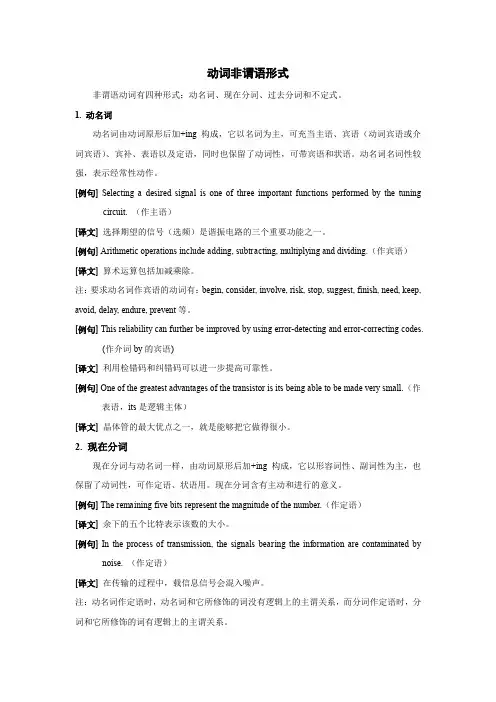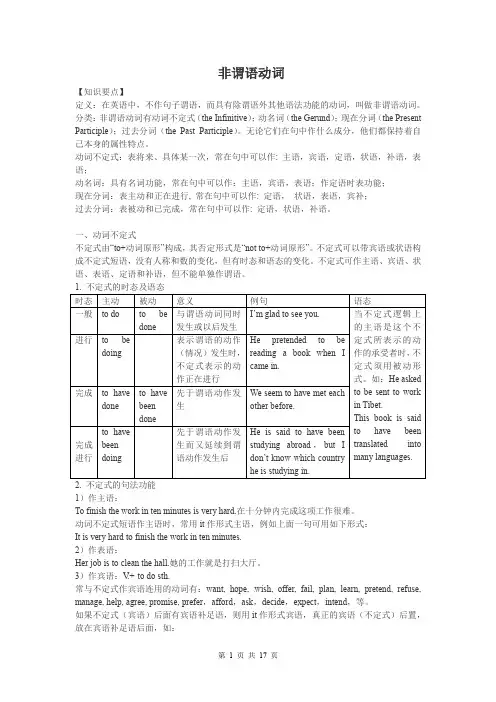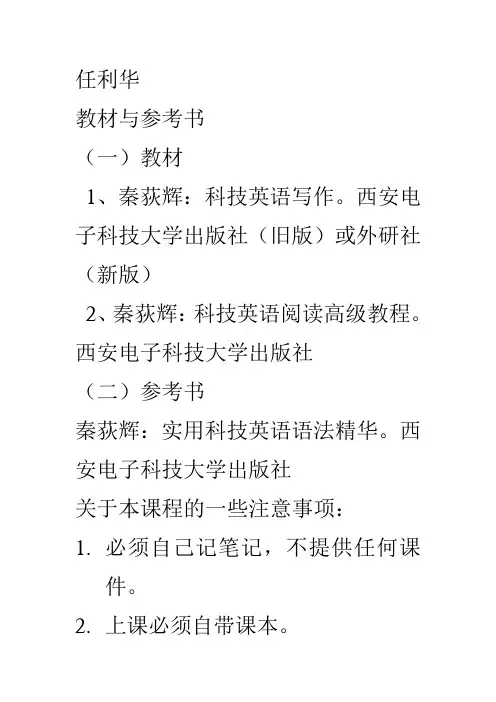西电科技英语课件——第四章_动词非谓语形式
- 格式:pps
- 大小:842.50 KB
- 文档页数:141

动词非谓语形式非谓语动词有四种形式:动名词、现在分词、过去分词和不定式。
1. 动名词动名词由动词原形后加+ing构成,它以名词为主,可充当主语、宾语(动词宾语或介词宾语)、宾补、表语以及定语,同时也保留了动词性,可带宾语和状语。
动名词名词性较强,表示经常性动作。
[例句] Selecting a desired signal is one of three important functions performed by the tuning circuit. (作主语)[译文] 选择期望的信号(选频)是谐振电路的三个重要功能之一。
[例句] Arithmetic operations include adding, subtracting, multiplying and dividing.(作宾语)[译文] 算术运算包括加减乘除。
注:要求动名词作宾语的动词有:begin, consider, involve, risk, stop, suggest, finish, need, keep, avoid, delay, endure, prevent等。
[例句] This reliability can further be improved by using error-detecting and error-correcting codes.(作介词by的宾语)[译文] 利用检错码和纠错码可以进一步提高可靠性。
[例句] One of the greatest advantages of the transistor is its being able to be made very small.(作表语,its是逻辑主体)[译文] 晶体管的最大优点之一,就是能够把它做得很小。
2. 现在分词现在分词与动名词一样,由动词原形后加+ing构成,它以形容词性、副词性为主,也保留了动词性,可作定语、状语用。





非谓语动词【知识要点】定义:在英语中,不作句子谓语,而具有除谓语外其他语法功能的动词,叫做非谓语动词。
分类:非谓语动词有动词不定式(the Infinitive);动名词(the Gerund);现在分词(the Present Participle);过去分词(the Past Participle)。
无论它们在句中作什么成分,他们都保持着自己本身的属性特点。
动词不定式:表将来、具体某一次,常在句中可以作: 主语,宾语,定语,状语,补语,表语;动名词:具有名词功能,常在句中可以作:主语,宾语,表语;作定语时表功能;现在分词:表主动和正在进行, 常在句中可以作: 定语,状语,表语,宾补;过去分词:表被动和已完成,常在句中可以作: 定语,状语,补语。
一、动词不定式不定式由“to+动词原形”构成,其否定形式是“not to+动词原形”。
不定式可以带宾语或状语构成不定式短语,没有人称和数的变化,但有时态和语态的变化。
不定式可作主语、宾语、状语、表语、定语和补语,但不能单独作谓语。
2. 不定式的句法功能1)作主语:To finish the work in ten minutes is very hard.在十分钟内完成这项工作很难。
动词不定式短语作主语时,常用it作形式主语,例如上面一句可用如下形式:It is very hard to finish the work in ten minutes.2)作表语:Her job is to clean the hall.她的工作就是打扫大厅。
3)作宾语:V.+ to do sth.常与不定式作宾语连用的动词有:want, hope, wish, offer, fail, plan, learn, pretend, refuse, manage, help, agree, promise, prefer,afford,ask,decide,expect,intend,等。




第四章动词非谓语形式主讲: 蒋维静2011年10月§4 .1 动词不定式1、普通不定式:其功能有“主、宾、表、定、状、补”
特点:(1)主语
ⅰ、句子谓语必定为单数第三人称形式ⅱ、往往可用形式主语“it”的句型§4 .1 动词不定式~1、普通不定式①“It+ 系动词+ 表语+ 不定式”(1)主语
It is of great interestto study the three laws of motion.
It proves convenientto describe the ability to conduct current in terms of conductance(电导).§4 .1 动词不定式~1、普通不定式(1)主语
It is possible to (do …)It is necessary to (do …)It is a simple matter to (do …)
“我们能够……”“我们必须……”
“……是容易的”
①“It+ 系动词+ 表语+ 不定式”§4 .1 动词不定式~1、普通不定式②“It+ 及物动词(take★, require, do, make)+ 宾语+ 不定式”
(1)主语
It takessunlight about 8minutes to reach the earth.
磁化(magnetize)这些物质需要一个强磁场。§4 .1 动词不定式~1、普通不定式(1)主语
It requiresa strong magnetic field to magnetize these substances.
②“It+ 及物动词(take★, require, do, make)+ 宾语+ 不定式”§4 .1 动词不定式~1、普通不定式(1)主语
解这个方程花了我们两个小时。②“It+ 及物动词(take★, require, do, make)+ 宾语+ 不定式”§4 .1 动词不定式~1、普通不定式(1)主语②“It+ 及物动词(take★, require, do, make)+ 宾语+ 不定式”
It tookus two hours to solve this equation. §4 .1 动词不定式~1、普通不定式③“It+ 不及物动词(suffice, work, help, occur)+ 不定式”(不常见)
(1)主语
It sufficesto give one example here.
西安电子科技大学§4 .1 动词不定式~1、普通不定式
④“It+ 被动语态(desire, leave, find, propose)[ + 主补等] + 不定式”
(1)主语
It is desiredto solve the equation for the unknown(未知量).
It is leftas a problem to show that these equations reduce to(简化成)Eq. (2–7)when the point lies on the x-axis. §4 .1 动词不定式~1、普通不定式①不定式的被动形式作宾语的情况(2)宾语:注意以下两点。
These problems deserve to be further studied.
[= It is worth studying these problems further.] §4 .1 动词不定式~1、普通不定式②一个用形式宾语“it”的常用句型(2)宾语:注意以下两点。
“主→谓→it→宾补→不定式”We find itvery difficult to solve this problem.
We consider itnecessary to make measurements with accuracy.
西安电子科技大学§4 .1 动词不定式~1、普通不定式特点:(3)表语
ⅰ、主表概念相等ⅱ、只能是主动形式的不定式ⅲ、一般只能用“is”,且可译成“是”★[否则是一种将来时形式,译成“将;要;
应该;会”]
西安电子科技大学§4 .1 动词不定式~1、普通不定式(3)表语The function of an antenna(天线)is to transmit or receive radio waves.
*** We are to discussthis point in the next chapter.
*** This component(元件)is to be chosenso that the transistor operates linearly(线性地).
西安电子科技大学§4 .1 动词不定式~1、普通不定式(3)表语*** Suppose that this milliammeter(毫安表)is to be usedas an ammeter(安培表)with a full-scale deflection(满刻度偏转)of 2A.
*** Several points are to be noted(注
意)in connection with the circuit.
西安电子科技大学§4 .1 动词不定式~1、普通不定式(3)表语
*** Feedback control systems are to be foundin almost every aspect of our daily environment.
西安电子科技大学§4 .1 动词不定式~1、普通不定式注:若在句子的主语部分有实意动词“do”的任何形式时,作表语的不定式的标志“to”可以省去。
What … do is (to)~All that … do is (to)~The best way to do is (to)~The only thing we must do is (to)~
西安电子科技大学§4 .1 动词不定式~1、普通不定式注:若在句子的主语部分有实意动词“do”的任何形式时,作表语的不定式的标志“to”可以省去。
All we need to do is measurethe voltage across this resistor.
What we can do is considerthe input to be a sum of functions(函数).
西安电子科技大学§4 .1 动词不定式~1、普通不定式①普通不定式作定语时,往往可表示“能够”或“将来”之意。
(4)定语
An ohmmeter is a device to measure resistance. [≈that can measure resistance]
Ris the resistance to be measured. [≈that will be measured]
西安电子科技大学§4 .1 动词不定式~1、普通不定式②不定式作定语时与被定词之间存在以下四种逻辑关系:
(4)定语
A、主谓关系(可以是主动的,也可以是被动的,可扩展成定语从句,如上面两例)
西安电子科技大学§4 .1 动词不定式~1、普通不定式B、动宾关系(可扩展成定语从句)There are two cases to consider. [≈that we shall consider]
We now have four equations to solve. [≈that we shall solve]
西安电子科技大学§4 .1 动词不定式~1、普通不定式C、不定式短语尾部的介词与介宾的关系(可扩展成定语从句)
Will you please give me a sheet of paper to write on?[= on which to write ≈on which I can write]
西安电子科技大学§4 .1 动词不定式~1、普通不定式Each member has a switch with which to indicate a YES or NO vote(投票).
*** An anchor point(抛锚处)refers to a place where[= at which]to secure(栓住)
a ship with an anchor(锚).
西安电子科技大学